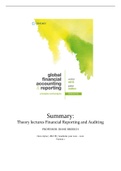Summary
Summary Financial Reporting and Auditing Theory Lectures ('21 - '22)
- Course
- Institution
- Book
Comprehensive summary of the lectures for the course Financial Reporting and Auditing. Suitable for students International Business. Given by Diane Breesch at the Vrije Universiteit Brussel in the academic year .
[Show more]



